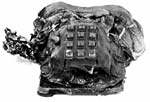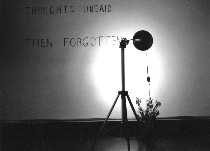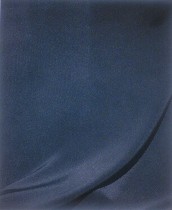
The Big Nothing at the ICA is one of those shows that has such a range of work in it, it almost doesn’t make sense to talk about the individual pieces but it does make sense to talk about the concept.
But I have to admit I saw the concept as more of an excuse for a show than something to take all that seriously. It’s not that I don’t think that nothingness isn’t a concept in contemporary art. I do. And I think that nothingness is a concept in much of this work.
 But there’s nothingness and nothingness. Some nothingness is about futility — I’d put Bas Jan Ader’s film “I’m Too Sad to Tell You” in this category. It shows the artist so overcome with sadness that he is unable to stop weeping long enough to communicate something. His efforts and futile. The nothingness is not so much about no speech as about his inability to stop the tears.
But there’s nothingness and nothingness. Some nothingness is about futility — I’d put Bas Jan Ader’s film “I’m Too Sad to Tell You” in this category. It shows the artist so overcome with sadness that he is unable to stop weeping long enough to communicate something. His efforts and futile. The nothingness is not so much about no speech as about his inability to stop the tears.
Some nothingness is about absence of content. Maybe Robert Barry’s video, “Nothing,” which is nothing more than the word projected on the wall for 15 minutes, fits this one. One quick look and then you get it, except there’s nothing to get.
 Some nothingness is about somethingness. Another Ader piece, “Thoughts Unsaid, Then Forgotten,” implies a whole back-story that is unexpressed. (Roberta and I saw this and “I’m Too Sad to Tell You” at a Carnegie Biennial in Pittsburgh, and it was nice to see them both again, although this piece, which is an installation, looked quite different–less wistful–than it did at the Carnegie, where it took up a larger space.) Another communications failure is implied by Matt Mullican’s melted phones, “Untitled (Into the Fifth World)” (shown at top).
Some nothingness is about somethingness. Another Ader piece, “Thoughts Unsaid, Then Forgotten,” implies a whole back-story that is unexpressed. (Roberta and I saw this and “I’m Too Sad to Tell You” at a Carnegie Biennial in Pittsburgh, and it was nice to see them both again, although this piece, which is an installation, looked quite different–less wistful–than it did at the Carnegie, where it took up a larger space.) Another communications failure is implied by Matt Mullican’s melted phones, “Untitled (Into the Fifth World)” (shown at top).
Another video (which you can view on the web at this link), “Swamp,” from Nancy Holt and Robert Smithson, shows close up, in the grasses, a weedy plot along a highway, plants regarded as nothing because they are not cultivated, in a garden not a garden for the same reason. The whining cars are invisible and so are the filmmakers (but aren’t filmmakers almost always invisible, except via their message)? This is a different take on nothingness–it’s about things not valued and therefore usually invisible, made visible in the video.
 There were a number of pieces that seemed to be about death as well, which I suppose you could argue is something or nothing, depending on your point of view, but if you remember someone absent, it’s hardly nothing. It’s like a thought. It’s real. But it’s incorporeal. Gabriel Orozco’s “Empty Shoe Box” and “Yogurt Caps” fit the bill, as does James Welling’s “I” (from the “Drapes” series), in which a funereal black drape, it’s form barely visible, is the photo’s focus.
There were a number of pieces that seemed to be about death as well, which I suppose you could argue is something or nothing, depending on your point of view, but if you remember someone absent, it’s hardly nothing. It’s like a thought. It’s real. But it’s incorporeal. Gabriel Orozco’s “Empty Shoe Box” and “Yogurt Caps” fit the bill, as does James Welling’s “I” (from the “Drapes” series), in which a funereal black drape, it’s form barely visible, is the photo’s focus.
I suppose I’d also put Richard Artschwager’s vinyl black blips, shaped like submarine doors, which puntuate the walls of the show in unexpected places. I got a similar buzz out of James Lee Byars’ “Scroll,” a black blip shape that looks rather like a fingernail on top of a thumb. Both Artschwager and Byar give us an opening into nowhere or no opening at all.
Whether all this adds up to incoherence or not, this is a show worth seeing.









